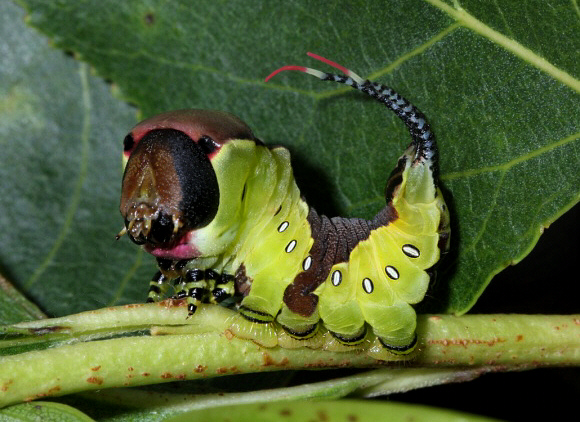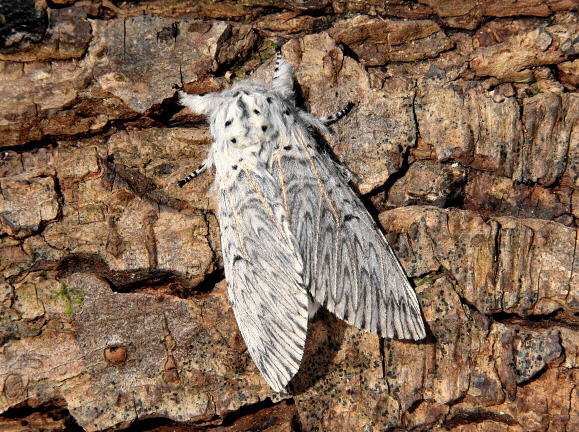 Cerura vinula, Dorset, England – Peter Bruce-Jones
Cerura vinula, Dorset, England – Peter Bruce-Jones
Introduction
The family Notodontidae comprises of about 3800 species. The moths are found in all regions of the world, with the greatest diversity and abundance in the Amazonian rainforests. The adults of most species are coloured in subtle hues of brown, grey and/or white, cryptically patterned with blotches or striations.
Some such as the Buff-tip Phalera bucephala (subfamily Phalerinae) are wonderfully disguised as snapped twigs. Others include the Pale Prominent Pterostoma palpina (Notodontinae) which is almost indistinguishable from a piece of broken wood, and the Lobster moth Stauropus fagi (Heterocampinae) which looks exactly like a bit of tree bark.
One unusual tropical subfamily is the Dioptinae which comprises mostly of aposematically patterned black and yellow day-flying species. Another interesting subfamily is the Thaumetopoeinae, whose larvae form swarms and follow each other head-to-tail from place to place as they feed, hence the popular name ‘processionary moths’.
Members of the subfamily Notodontinae are all cryptically patterned nocturnal species. They have long cylindrical abdomens, and furry forelegs which project forwards in front of the head when the moths are at rest. In many species, the inner margins of the forewings have prominent lobes which project above the thorax when the wings are folded over the body, giving rise to the common term ‘prominent’ moths.
The genus Cerura is usually classified as belonging to the Notodontinae but some workers place it in the Heterocampinae, or include it and the closely allied genus Stauropus in the Stauropinae.
There are 21 Cerura species, distributed variously from Europe to Indonesia. Cerura vinula is found throughout Europe, and across temperate Asia to China.
Habitats
This species is found in deciduous woodland at altitudes between sea level and about 1000m. It can also be found in gardens and suburban parks.
Lifecycle
The eggs are reddish-brown and dome-shaped. They are laid singly or in clusters of 3 or 4 on the upper surface of leaves of the foodplants which include sallow Salix, and poplars Populus.
The caterpillar is disruptively patterned in green and purplish brown, making it very difficult to find when at rest among green foliage. In common with other Notodontinae species, it rests with its head and tail raised. Its anal claspers are highly modified into a pair of long upcurved tails. If molested by parasitoid wasps or flies, the caterpillar adopts a threatening pose by retracting its head into the first thoracic segment, causing this to expand, revealing a pink face with a pair of black false-eye markings. If further molested it swings its head violently from side to side and extrudes bright red whip-like structures from the tail horns. These are waved in the air and disseminate airborne formic acid vapour, which deters further attack.
The pupa is formed on the lower part of a tree trunk, within a cocoon comprised of silk interwoven with numerous tiny pieces of chewed bark. The shell of the cocoon is extremely hard, and almost impossible to distinguish from the surrounding bark. Prior to emergence, the newly hatched moth uses a solvent exuded from its mouthparts to soften the cocoon and force its way out.
Adult
The adult is white, patterned with grey and black wavy lines. The forelegs are white and very furry, and project forward giving the appearance of cat’s ears, hence the common name Puss moth.
 Cerura vinula, Dorset, England – Peter Bruce-Jones
Cerura vinula, Dorset, England – Peter Bruce-Jones
